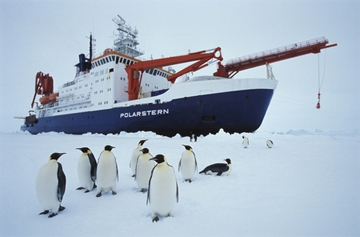Iron fertilization of oceans less effective in sequestering carbon than previously estimated
|
|
Schemes to promote increased carbon uptake by plankton via iron fertilization of oceans will be less effective than previously believed, report researchers writing in the journal Nature.
Raymond Pollard of the National Oceanography Centre in Southampton, UK and colleagues aboard the British vessel RSS Discovery measured the amount of carbon dioxide that is sequestered in the deep ocean by plankton when it dies and found the amount to be 80 times lower than estimated during an earlier study.
The researchers say the results reveal the complexity of the ocean carbon cycle.
“We know that carbon is transported to the deep ocean and seabed via the plankton, but the question is how much and for how long?” added Gary Fones, a marine biogeochemist at the University of Portsmouth’s School of Earth and Environmental Science who was part of the team. “The combined results of all the studies undertaken so far indicate that there could be other factors influencing the amount of carbon exported.”
 R/V Polarstern Courtesy of the Alfred Wegener Institute for Polar and Marine Research. |
The study comes just three days after the German science ministry gave the go-ahead on a controversial ocean-fertilization experiment by German and Indian scientists aboard the R/V Polarstern in the Southern Ocean. The LOHAFEX experiment plans to dump 20 tons of iron sulphate into the sea and measure the carbon uptake by plankton.
Last year a similar experiment by Planktos, a private firm which sought to sell offsets for the carbon the project sequestered, was thwarted after concerns were raised over the environmental impacts. Opponents argued that the company failed to take proper safeguards to protect marine life and that the results of the geoengineering scheme would be nearly impossible to measure.
The LOHAFEX experiment has faced similar concerns and has been widely condemned by environmentalists. Supporters of the project say the amount of iron to be introduced to the marine ecosystem pales in comparison to the amounts added daily by natural processes.
The new Nature study looked specifically at the impact of natural iron fertilization in the form of iron-rich dust that blows into the ocean off the Crozet Islands some 2000 km southeast of South Africa. The study found that while iron “triggered a two- to threefold increase in biological productivity over an area the size of Ireland” it did not store as much carbon at depths as previous research had suggested, according to Nature News. Carbon that remains in the upper ocean is more likely to re-enter the atmosphere than be locked away for centuries or millennia in deep ocean sediments.
“You might get a different response if you shock the system by dumping a lot of iron all at once,” Pollard told Nature News. “The effect will still be much smaller than some geoengineers would wish.”
The findings cast doubt on estimates by some researchers that iron fertilization of vast areas of ocean might have the capacity to sequester as much as 30 percent of human emissions.
“Ocean iron fertilization is simply no longer to be taken as a viable option for mitigation of the CO2 problem,” Hein de Baar, an oceanographer at the Royal Netherlands Institute for Sea Research in Texel, told Nature News.
CITATION
- Pollard, R. T. et al. Nature 457, 577–580 (2009).
- Schiermeier, Q. Ocean fertilization: dead in the water? Nature 457, 520-521 (2009) | doi:10.1038/457520b